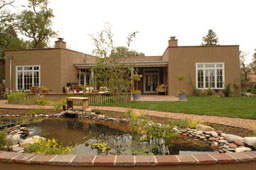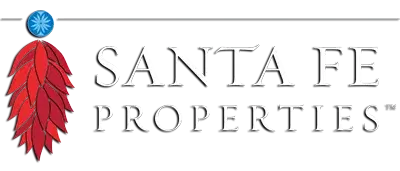Santa Fe Architecture
“Santa Fe style” architecture is only some 1,600+ years old…
The graceful and symmetrical lines of the adobe or adobe-like homes and buildings that enchant you today have their roots in dwellings built by the Anasazi, or predecessors of the modern Pueblo people nearly two millennia ago. Built of adobe or stone, ancient Indian settlements blended harmoniously into the surrounding landscape.
Spanish Colonial influences filtered in beginning in the 1500s, followed by an influx of Greek Revival and Victorian touches from the East in the 1800s, and then an intense interest in Spanish/Pueblo Revival in the early 1900s.
The result is a fusion of eclectic elements that celebrates our diverse culture, reflects our interest in the environment (especially use of passive/solar construction) and natural materials – all enhanced by individual expression and an artistic aesthetic.
Here’s a short primer on Santa Fe architectural influences:
 Pueblo Style
Pueblo Style
Derived from traditional southwestern Indian pueblos, this style of adobe architecture is typified by soft, organic lines and rounded corners and parapets. Pueblo homes were historically one or two stories and featured low doorways, small windows, mud roofs and adobe walls. Today’s pueblo homes share much with their ancestors, such as vigas, latillas, nichos, canales and bancos. Today’s homes have also been updated with windows, high ceilings and hard plaster finishes and feature open floor plans.
 Territorial Style
Territorial Style
Prior to statehood in 1912 while New Mexico was still a territory, the railroad arrived bringing with it heavy sawmill equipment. Milled wood moved architecture from simple mud structures to ornate, finished multi-story buildings. The territorial style features stucco exteriors with sharp-edged parapet walls, often decorated with brick coping. The windows and doors are usually bordered with Victorian style detail. The interior of these homes is highly finished with sharp corners, milled beams and wood trim.
 High-Mountain Pitched Roof style
High-Mountain Pitched Roof style
Due to heavy snows in northern New Mexico, the historic mud roofs of pueblo and territorial architecture became impractical. To get rid of heavy snow, early settlers resorted to pitched thatch roofs, which in time became corrugated metal roofing. In today’s homes, the pitched roofs are covered with iodized raised ridge roofing in bright colors ranging from rust red to turquoise blue.
Shapes of Things to Come
Santa Fe isn’t just about Pueblo or Territorial Styles any more. With each passing year, the architectural landscape of Santa Fe is growing and evolving to reflect new and contemporary aesthetics and exciting fusions of culture and design. New adobe homes now frequently incorporate Far-Eastern elements and continental European Style, in a rich blend of Old World and new.
Santa Fe now has it’s own versions of “the loft” – retro interpretations of the ancient “apartment style” multiple-storied dwellings of the Anasazi; a new influx of urban creativity and flair akin to those wide-open warehouses of space for living and working found in New York, LA, Philadelphia and other big cities. Of course, Santa Fe lofts and their close cousin, the townhouse/condo, usually have a distinctive Pueblo influence, recently more contemporary influences have found their way into the Santa Fe landscape.
